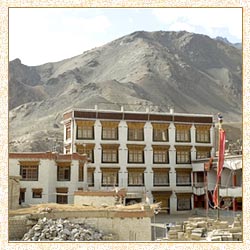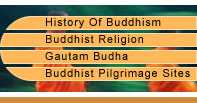 Lamayuru Monastery is situated in Ladakh, in between Bodhkharbu and Kha-la-che, on a steep rock mountain. It lies at a distance of approximately 127 km to the west of Leh town. Lamayuru Monastery belongs to the Red-Hat sect of Buddhism and houses approximately 150 Buddhist monks. The monastery is made up of a number of shrines and also has a very rich collection of thankas and magnificent wall paintings. At the outset, the Lamayuru Monastery consisted of five buildings, out of which only the central one exists today.
Lamayuru Monastery is situated in Ladakh, in between Bodhkharbu and Kha-la-che, on a steep rock mountain. It lies at a distance of approximately 127 km to the west of Leh town. Lamayuru Monastery belongs to the Red-Hat sect of Buddhism and houses approximately 150 Buddhist monks. The monastery is made up of a number of shrines and also has a very rich collection of thankas and magnificent wall paintings. At the outset, the Lamayuru Monastery consisted of five buildings, out of which only the central one exists today.Every year the Lamayuru Gompa plays host a masked dance, which takes place on the 17th and 18th day of the 5th month of Tibetan lunar calendar. The monks from the monasteries of the nearby areas also come to take part in the celebrations. There is an interesting legend associated with the Lamayuru Gompa of Leh Ladakh. It is said that the Lamayuru Valley used to be a clear lake, at the time of Sakyamuni (the Historical Buddha). And, nags (holy serpents) used to reside in the lake.
Bodhisattva Madhyantaka had once a prediction quite a long time back that the lake would eventually be dried, making way for the construction of a Buddhist monastery. The legend moves further to state that Mahasiddhacharya Naropa, an 11th century Indian Buddhist scholar, sat in meditation for a number of years in one of the caves in Dukhang. He was the one who caused a crack in the hillside surrounding the lake.
Through this crack, the lake started draining. When the lake dried out, the scholar found a dead lion lying inside it. On the same spot, where he found the tiger, he constructed the first temple of the area, known as the Singhe Ghang (Lion Mound). Another legend has it that the building of Lamayuru Monastery was constructed, as per the instructions of King of Ladakh, under the direction of Rinchen Zangpo, the Translator. After this, the monastery came under the administration of the Zhwa-mar-pa (Red Hats).
Later, Dharmaraja Jamyang Namgial offered the monastery to Chosje Danma. And this led to the observance of the rituals of the Digung Kargyud School, with the monastery being renamed as Yungdrung Tharpaling. Today, the Lamayuru Monastery is served by the successive reincarnations of Skyabsje Toldan Rinpoche.





